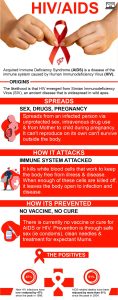02 Dec HIV/AIDS
This article covers “Daily Current Affairs” and the topic details “ HIV/AIDS”. This topic has relevance in the Social Issues section of the UPSC CSE exam.
GS 2: Social Issues
Why in the news?
World AIDS Day is observed every year on December 1 to spread awareness about HIV/AIDS.
Background of Origin of HIV in Humans:
- HIV infection in humans has its roots in a type of chimpanzee in Central Africa. Research indicates that the transfer of the virus from chimpanzees to humans likely occurred as early as the late 1800s.
- The chimpanzee version of the virus is known as the simian immunodeficiency virus (SIV). SIV is endemic in chimpanzee populations and has a genetic similarity to HIV.
- The transmission from chimpanzees to humans is believed to have taken place during hunting activities. Humans, while hunting chimpanzees for meat, came into contact with the infected blood of these animals.
About HIV/AIDS
- HIV/AIDS is a chronic and potentially life-threatening condition caused by the human immunodeficiency virus (HIV).
- The virus targets the immune system, rendering individuals more susceptible to infections and diseases.

Transmission:
- Primarily a sexually transmitted infection (STI), transmitted through sexual contact.
- Spread can also occur through contact with infected blood, often associated with illicit injection drug use or needle sharing.
- Mother-to-child transmission can happen during pregnancy, childbirth, or breastfeeding.
Progression to AIDS:
- In the absence of treatment, HIV has the potential to advance to acquired immunodeficiency syndrome (AIDS).
- AIDS represents an advanced stage of the infection, characterized by severe immune system damage.
Treatment:
- No definitive cure for HIV currently exists; individuals have the virus for life once infected.
- Effective management is achievable through antiretroviral therapy (ART).
- ART helps control the virus, allowing for a long and healthy life while minimizing the risk of transmission to partners.
Prevention:
- Engaging in safe sexual practices and employing barrier methods can lower the likelihood of sexual transmission.
- Avoiding sharing needles and practicing safe injection practices can prevent transmission through blood contact.
- Prevention of mother-to-child transmission involves interventions during pregnancy, childbirth, and breastfeeding.
HIV/AIDS in India:
- Declining Numbers: Over the last decade, the incidence of HIV in India has significantly decreased, reflecting positive strides in combating the epidemic.
- National AIDS Control Organization (NACO):
-
- NACO, a Government of India organization, plays a pivotal role in managing HIV patients, providing a robust network for diagnosis, treatment, and control.
- It operates through 35 HIV/AIDS Prevention and Control Societies across the country.
- Medical Advancements: The availability of Highly Active Anti-Retroviral Treatment (HAART) has notably improved the prognosis for HIV patients in the past two decades.
- Historical Context:
-
- The National AIDS Committee was formed in 1986 after the first AIDS case was detected in India.
- The increasing spread of the epidemic led to the launch of India’s first National AIDS Control Programme (1992-1999) in 1992, with the establishment of NACO to oversee its implementation.
Legal Framework – HIV and AIDS (Prevention & Control) Act, 2017:
- Enacted in 2017, this central legislation safeguards and promotes the rights of individuals affected by HIV and AIDS.
- Came into effect on September 10, 2018, with the primary goal of preventing and controlling the spread of HIV while protecting the legal and human rights of those impacted.
- Focuses on combating stigma and discrimination, creating an enabling environment for improved service access.
- Addresses the rights of healthcare providers and emphasizes diagnostic facilities related to Anti-Retroviral Treatment (ART) and opportunistic infection management.
- Establishes a robust grievance redressal mechanism, including a State-level Ombudsman and establishment-level Complaints Officer, ensuring speedy resolution.
Download plutus ias current affairs eng med 2nd Dec 2023
Q.1 With reference to HIV/AIDS, consider the following statements:
- HIV/AIDS is primarily transmitted through sexual contact.
- Mother-to-child transmission can occur during pregnancy, childbirth, or breastfeeding.
- Antiretroviral therapy (ART) is a definitive cure for HIV.
Which of the statements given above is/are correct?
(a) 1 and 2 only
(b) 2 and 3 only
(c) 1, 2 and 3
(d) 1 and 3 only
ANSWER: A
Q.2 Discuss the burden of disease in India Also, analyze the socio-economic disparities in health outcomes and propose measures to address them for achieving a healthier and more equitable society.



No Comments